Vibrating screens are widely used in the mining, agriculture, pharmaceutical, food, and chemical industries to separate materials based on size, shape, and density. They are commonly used for sorting, classifying, and sizing aggregates, minerals, coal, sand, and other materials.
There are several types of vibrating screens, each with its own unique working principle and design features. Some of the most common types of vibrating screens include:
Circular Vibrating Screen: This type of vibrating screen operates on a circular motion, which helps to efficiently separate and classify materials. The screen deck is typically inclined, allowing for the material to move across the screen surface. As the material moves across the deck, it is classified into different sizes based on its particle size distribution.
Linear Vibrating Screen: The linear vibrating screen operates on a straight-line motion, which helps to effectively remove impurities and contaminants from the material being processed. The screen deck is typically horizontal, and the material moves along the length of the screen surface. As the material moves, it is separated into different sizes based on its particle size distribution.

Working Principle of Vibrating Screens:
Vibrating screens work on the principle of breaking down large particles into smaller ones. The vibrating screen consists of a screen surface, which is made up of individual perforated plates, and a vibrating mechanism that causes the plates to vibrate at a high frequency.
As the material enters the screen, it is fed onto the screen surface. The vibrating mechanism then causes the material to move across the screen surface, with smaller particles passing through the perforations in the screen surface and larger particles being retained on the surface.
The size and shape of the perforations in the screen surface can be adjusted to allow for the separation of materials based on their particle size distribution. Additionally, the angle and inclination of the screen deck can be adjusted to optimize the screening process and improve overall efficiency.
Vibrating screens are an essential piece of equipment used in a wide range of industries to separate and classify materials based on their particle size distribution. They operate on a variety of different principles and designs, each with its own unique features and benefits. Understanding the different types of vibrating screens and their working principles can help you choose the right system for your specific needs.
